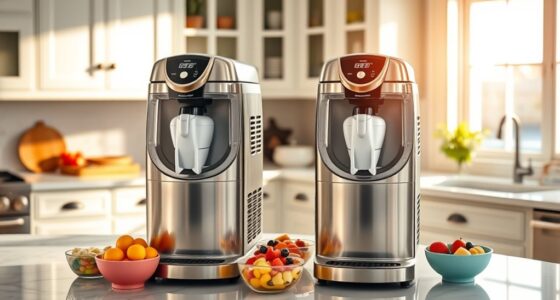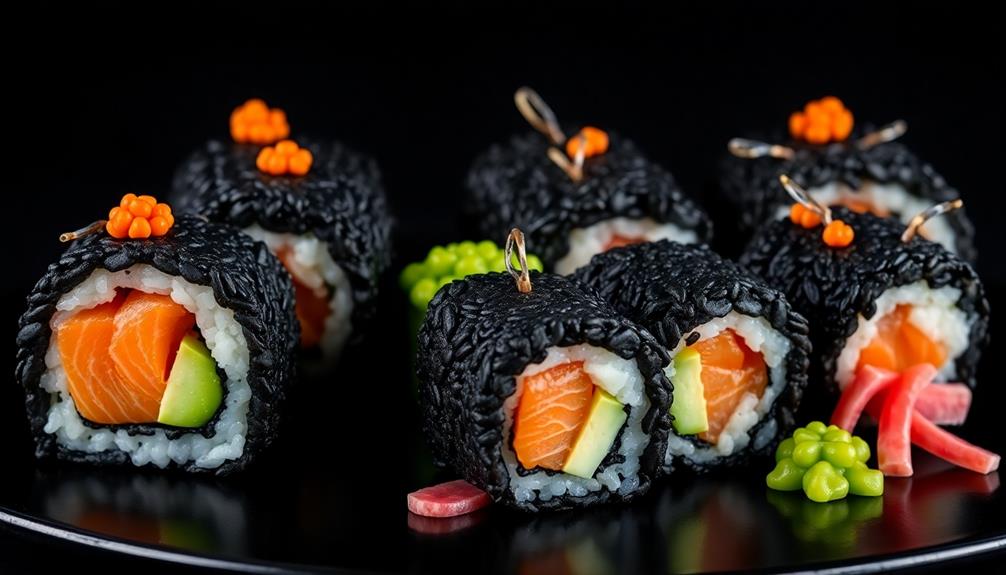If you’re choosing between gravity-fed and pressurized soft serve machines for profit, consider your business needs. Gravity-fed units are cheaper, easier to maintain, and great for quick service, which can boost volume and steady income. Pressurized machines, though more costly upfront, offer superior texture and premium appeal, often justifying higher prices. To maximize your earnings, weigh your budget against product quality and customer experience; more details can help you decide the best fit for your operation.
Key Takeaways
- Gravity-fed machines have lower upfront and maintenance costs, potentially increasing profit margins for small or budget-conscious businesses.
- Pressurized systems, despite higher initial investment, can produce higher-quality, premium products suitable for upscale markets.
- Ease of maintenance and operational simplicity of gravity-fed models reduce downtime, enhancing overall profitability.
- Both systems can be profitable; success depends on volume, pricing strategy, and customer preferences for quality and consistency.
- The choice influences long-term profitability, with pressurized units often enabling higher pricing for superior texture and appearance.

When choosing a soft serve machine, understanding the differences between gravity-fed and pressurized models can help you make an informed decision. Both types have unique features that influence your profits and customer satisfaction. Gravity-fed machines rely on gravity to feed the mix from a hopper into the freezing chamber. They’re generally simpler in design, which often means easier maintenance and fewer parts that can break down. This simplicity can be a significant advantage because it reduces downtime and service costs, allowing you to keep your machine running smoothly. Additionally, gravity-fed models tend to deliver more consistent flavor. Since they feed the mix at a steady rate, the flavor remains stable from one serving to the next, giving your customers a reliable experience that keeps them coming back. Incorporating farmhouse-style decor elements, like rustic signage or vintage accents, can enhance the overall ambiance of your soft serve shop, attracting more customers seeking a cozy, inviting environment. The straightforward operation of gravity-fed systems also means less training is needed for staff, which can save time and resources in your day-to-day operations.
Gravity-fed soft serve machines are simpler, more reliable, and deliver consistent flavor with less maintenance.
On the other hand, pressurized soft serve machines use a pump system to deliver the mix. This design allows for more precise control over the flow rate, which can lead to smoother, creamier textures. However, this complexity also makes maintenance more challenging. You’ll need to be prepared for more frequent cleaning, potential repairs, and a higher level of technical knowledge. That extra effort can cut into your operational efficiency if not managed properly. But if maintained correctly, pressurized machines can produce a very uniform product, minimizing air incorporation and ensuring each serving has a consistent texture and flavor. This consistency can be a selling point, especially in high-volume settings where customers expect the same quality every time.
In terms of making more money, the decision hinges on your priorities. Gravity-fed models are often more budget-friendly upfront and easier to maintain, which can translate into lower operational costs. Their consistent flavor quality also helps in building customer trust and loyalty. Conversely, pressurized models might require a larger initial investment and more ongoing maintenance, but they can produce a superior product with better texture and appearance, potentially allowing you to charge higher prices. If your focus is on quick turnover with minimal fuss, a gravity-fed machine might be the better choice. If you aim to differentiate your product and command a premium price, a pressurized model could be more profitable in the long run, despite the higher maintenance complexity. Considering cost of operation and long-term maintenance needs can help guide your decision for maximum profitability.
Ultimately, your choice depends on your business model, budget, and quality expectations. Both types can be profitable when used correctly, but understanding their differences in flavor consistency and maintenance will help you select the right machine to maximize your earnings.
Frequently Asked Questions
Which Soft Serve Machine Type Requires Less Maintenance?
You’ll find that pressurized soft serve machines generally require less maintenance because they have fewer moving parts and are less prone to clogging. With proper machine calibration and good ingredient quality, these machines stay in better shape longer. Gravity-fed machines might need more frequent cleaning and calibration due to their design and reliance on gravity, but both types benefit from regular maintenance to ensure peak performance.
How Does Machine Size Impact Profit Margins?
Your machine size considerably impacts profit margins. Larger machines can produce more servings, boosting revenue, but they also come with higher upfront costs and increased maintenance expenses. Smaller machines are more affordable and easier to maintain, helping you save on costs. You need to balance size and capacity carefully, as choosing the right machine size guarantees ideal profit margins without overspending or limiting your sales potential.
Are There Specific Flavors Better Suited for Each System?
You should consider flavor versatility and ingredient flexibility when choosing a soft serve system. Certain flavors, like fruit or alcohol-infused options, often work better with pressurized systems due to their consistency and ingredient stability. Meanwhile, gravity-fed machines excel with classic flavors like vanilla or chocolate, offering easier handling and quick serving. Matching flavors to your system guarantees smoother operation and better customer satisfaction, ultimately boosting your sales and profits.
What Are the Energy Consumption Differences Between the Systems?
Think of energy efficiency like a well-tuned engine; it saves you fuel and runs smoothly. When comparing systems, you’ll find pressurized soft serve machines typically have higher power consumption because they rely on compressors to maintain pressure. Gravity-fed systems use less energy, making them more energy-efficient overall. So, if you want to cut down on power consumption, a gravity-fed setup might be the smarter choice for lower energy costs.
Which System Has a Longer Lifespan and Durability?
When comparing durability, you’ll find that pressurized systems generally have a longer lifespan because they’re built with more robust components to withstand constant pressure. Lifespan factors like maintenance and usage frequency also matter, but overall, pressurized soft serve machines tend to be more durable. Your choice depends on your needs—if you want longevity and fewer repairs, a pressurized system offers better durability compared to gravity-fed options.
Conclusion
Ultimately, choosing between gravity-fed and pressurized soft serve machines depends on your business goals. For example, a small ice cream shop might see higher profits with a pressurized machine that offers smoother, consistent servings, attracting more customers. On the other hand, a concession stand may benefit from a gravity-fed machine’s lower initial cost. Consider your space, budget, and customer preferences to decide which setup will maximize your earnings and keep your customers coming back.










